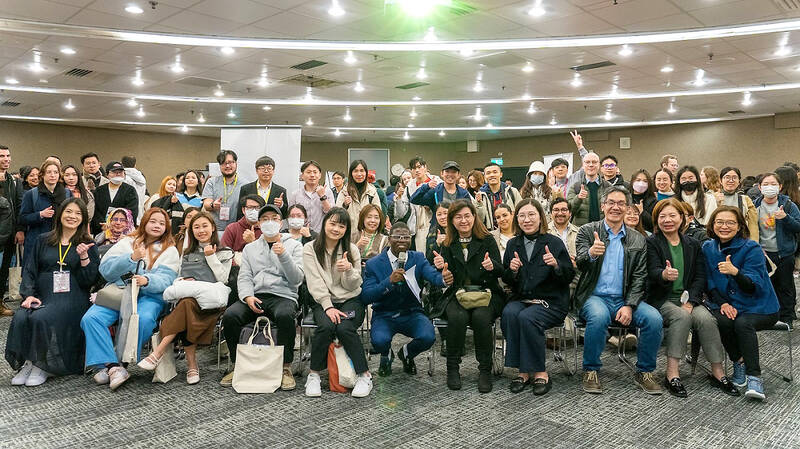With a booming tech sector and recent graduates flooding the market, many people are looking for jobs. If you are looking for a career in international business, LinkedIn is a must-have tool in your job finding toolbox. As long as it is used in the right way.
As a headhunter in the tech industry with 42,000 followers on LinkedIn (Amy) and an educator and published book author on LinkedIn and Job application writing (Nigel), we want to help you avoid the three biggest mistakes Taiwanese LinkedIn users make when looking for a job. And how to fix them.
WHY USE LINKEDIN?

Photo courtesy of the Ministry of Education
LinkedIn is the only social media for professionals. With 63 million corporate customers worldwide and 98 percent of Fortune 500 companies recruiting on LinkedIn, it is a powerful job search platform.
LinkedIn is slowly becoming more popular in Taiwan, especially with the younger generation. In 2022, the number of Gen Z users (16- to 26-year-olds) increased by 41 percent. However, it is interesting that there remains few LinkedIn users in Taiwan. In Hong Kong, over 70 percent of people have LinkedIn accounts. In Taiwan it is 13 percent.
Many Taiwanese still use job banks like Job Bank 104, CakeResume or Yourator to look for a job. And because their friends, family and teachers may not be familiar with LinkedIn, they assume it is not important or useful.

Photo: Reuters
Or, they may feel intimidated by all the English on LinkedIn. This is a shame since there are tools like ChatGPT to make writing in English relatively effortless. And LinkedIn has AI tools baked in to translate posts and even full courses into Chinese.
From our experiences as a headhunter and educator, we have found Taiwanese LinkedIn users make three common mistakes: incomplete profile, lacking detailed information and difficult-to-read language.
TIP 1: COMPLETE PROFILE
Even though the LinkedIn profile has three key sections (headline, about section and experiences section), there are many other sections that you can add information to, like education, licenses, skills and recommendations.
The more complete your profile is for a sales rep in the tech industry, for example, the more sales and tech related words will appear in your profile. This means you will be easier for recruiters (or anyone) to find when they are looking for a sales rep in tech. This is how search engine optimization works for Web sites.
Most Fortune 500 companies use LinkedIn’s recruiter system, a powerful tool that uses an intelligent algorithm to help recruiters find potential candidates. It uses over 40 advanced search filters, including skills, past experiences and location, to find the most suitable candidates for a job.
TIP 2: DETAILED INFORMATION
Many job seekers do not spend enough time writing their resumes or LinkedIn profiles. Just like with any form of writing, you need to know what information your reader needs and how to present it in the way they expect.
Let’s continue with the sales example. If you are a sales rep who has worked at a few companies, you need to spend time adding enough job details to help the non-specialist, like the HR officer or headhunter. The reader probably won’t know what your company does, and what products they sell or which products you worked on. This context information helps recruiters understand better if you are a good fit for the position they are trying to fill.
Numbers are very important for complete information but also credibility. How many years’ experience do you have? What were your contributions and achievements? Numbers are the language of persuasion that recruiters are looking for.
TIP 3: EASY-TO-READ LANGUAGE
The “about” section is where you want to highlight your personality, skills, experience and education that are most relevant for the job you are applying for. This also means making your achievements and contributions as clear as possible.
This is not the place to talk about your family history or your life philosophy. Recruiters only want to see the relevant details, as quickly and as easily as possible.
So, it is a good idea to use short sentences and paragraphs, and where possible use bullets. Avoid technical jargon or abbreviations that may not be understood by everyone. Focus on making the language as easy as possible for everyone to read.
AI tools like Google Gemini or ChatGPT are good for this. Give the AI your relevant details and ask it to write a LinkedIn “about” section in short sentences and paragraphs and where possible, bullets.
Following these three tips will sharpen your most useful tool for finding a job at an international company. Once you complete your profile, add many relevant details about your skills and experiences, make your language as readable as possible, you will be able to take advantage of the power of LinkedIn and increase success in your job search.
Nigel P Daly is an author and business communications instructor at TAITRA’s International Trade Institute. He has a PhD in English, TESOL, from National Taiwan Normal University.
Amy Pang is a headhunter by profession and a mother by identity and runs a website called 99moms. She shares articles about work and life on LinkedIn for more than 42,000 followers.

When Taiwan was battered by storms this summer, the only crumb of comfort I could take was knowing that some advice I’d drafted several weeks earlier had been correct. Regarding the Southern Cross-Island Highway (南橫公路), a spectacular high-elevation route connecting Taiwan’s southwest with the country’s southeast, I’d written: “The precarious existence of this road cannot be overstated; those hoping to drive or ride all the way across should have a backup plan.” As this article was going to press, the middle section of the highway, between Meishankou (梅山口) in Kaohsiung and Siangyang (向陽) in Taitung County, was still closed to outsiders

US President Donald Trump may have hoped for an impromptu talk with his old friend Kim Jong-un during a recent trip to Asia, but analysts say the increasingly emboldened North Korean despot had few good reasons to join the photo-op. Trump sent repeated overtures to Kim during his barnstorming tour of Asia, saying he was “100 percent” open to a meeting and even bucking decades of US policy by conceding that North Korea was “sort of a nuclear power.” But Pyongyang kept mum on the invitation, instead firing off missiles and sending its foreign minister to Russia and Belarus, with whom it

President William Lai (賴清德) has championed Taiwan as an “AI Island” — an artificial intelligence (AI) hub powering the global tech economy. But without major shifts in talent, funding and strategic direction, this vision risks becoming a static fortress: indispensable, yet immobile and vulnerable. It’s time to reframe Taiwan’s ambition. Time to move from a resource-rich AI island to an AI Armada. Why change metaphors? Because choosing the right metaphor shapes both understanding and strategy. The “AI Island” frames our national ambition as a static fortress that, while valuable, is still vulnerable and reactive. Shifting our metaphor to an “AI Armada”

The Chinese Communist Party (CCP) has a dystopian, radical and dangerous conception of itself. Few are aware of this very fundamental difference between how they view power and how the rest of the world does. Even those of us who have lived in China sometimes fall back into the trap of viewing it through the lens of the power relationships common throughout the rest of the world, instead of understanding the CCP as it conceives of itself. Broadly speaking, the concepts of the people, race, culture, civilization, nation, government and religion are separate, though often overlapping and intertwined. A government